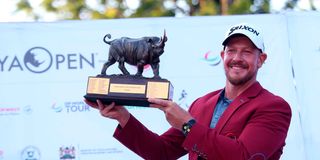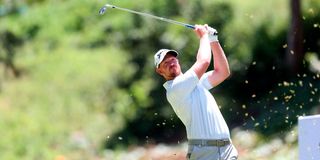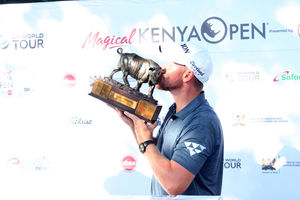
South Africa’s Jacques Kruyswijk lifts the Magical Kenya Open title at Muthaiga Golf Club on February 23, 2025.
The 2025 Magical Kenya Open (MKO) is now complete, and attention in the DP World Tour shifts to South Africa for the Investec South African Open this weekend, followed by the Joburg Open next week.
The fast-growing DP World Tour is now structured into several swings, starting with the “Opening Swing”, which took place in November last year.
This included the BMW Australian PGA Championship, the ISPS Handa Australian Open, South Africa’s Nedbank Golf Challenge, the Alfred Dunhill Championship in South Africa, and the AfrAsia Bank Mauritius Open.
The MKO was part of the International Swing, alongside events such as the Hero Dubai Desert Classic—one of the oldest tournaments in the Middle East—followed by the Ras Al Khaimah Championship and the Bahrain Open.
These events led up to last week’s 56th edition of the MKO, a tournament that has been part of the European Tour since 2019, thanks to support from the Kenyan government.
The MKO has steadily grown, now boasting a $2.5 million prize purse. It has served as a launching pad for many top players, including 2025 champion Jacques Kruyswijk from South Africa.
He follows in the footsteps of fellow South Africans such as Justin Harding, who won the 2021 edition with a record 21-under-par, and Trevor Immelman, who became the first South African to claim the title in 2000.
Eight years after his MKO win, Immelman went on to win the 2008 US Masters, highlighting the tournament’s role in developing world-class talent.
While foreign players continue to use the MKO as a stepping stone to global success, Kenyan professionals remain far from making a breakthrough. Since Jacob Okello’s near victory in 1998, when he lost in a playoff to Argentina’s Ricardo Gonzalez, no Kenyan has come close to winning.
This year, 13 Kenyan professionals and six amateurs were among the 150-player field, but none made the cut. Even Riz Charania (-2) and Daniel Nduva (-1), who had promising starts, fell short.
The last Kenyan to make the cut was Mutahi Kibugu in 2023, finishing 65th at -1, though he struggled in the final round. His younger brother, Njoroge Kibugu, made the cut in 2022 but missed out this year, as did senior pro Dismas Indiza.
Despite Mutahi’s promising start (+2 in round one), he needed just two shots to make the level-par cut but failed to recover in round two.

Krusyswijk Jacques reacts to his putt at the 16th hole green on February 22, 2025, during the Magical Kenya Open Golf tournament at Muthaiga Golf Club.
Many believe the lack of consistent competition is a key factor in the struggles of Kenyan golfers. Riz Charania, 41, cited limited competitive play as a major challenge:
“I just had a poor start on day two and found it hard to recover. After analysing my round, I made mistakes in shot selection, leading to three bogeys in the first three holes. This is just due to a lack of competitive golf in the last year.”
Charania believes local pros need at least 25 events annually to stay sharp.
“We need more events, coaching access, equipment, and long-term sponsorships so players can compete full-time. This should be a three-to-five-year project requiring serious commitment and investment from stakeholders.”
His concerns are echoed by golf legend Elisha Kasuku, who argues that short-term financial support isn’t the solution:
“Giving a pro a million shillings three days before the Open won’t improve performance. It covers expenses but doesn’t prepare a player mentally or physically. The solution is long-term planning with more competitive events.”
Kasuku recalls how past players travelled to Nigeria, Côte d’Ivoire, Zambia, and Zimbabwe before the Kenya Open, ensuring they were battle-ready:

Krusyswijk Jacques follows his tee shot from second tee on February 22, 2025 during Magical Kenya Open Golf tournament at Muthaiga Golf Club.
“This is why players like Jacob Okello and John ‘Wonder Boy’ Ngugi performed well. They had serious competitions before the Open, unlike today’s pros.”
Ken Mwige, Director General of Kenya Vision 2030, has a different take, urging a fundamental shift in approach:
“Doing the same thing over and over and expecting different results is insanity. We need to align corporate interests with national goals. The MKO is bigger than any Kenyan brand, including Safaricom. Synergy and collaboration will yield better results than individual efforts.”
Mwige argues that Kenya’s fragmented approach to golf development isn’t working, citing the KCB, NCBA, and Safaricom-sponsored tours as examples of disconnected efforts.
“A seismic change is needed. Otherwise, we’ll keep getting the same results. There’s a huge gap between our players and international pros. The future lies in juniors and a well-structured, medium-term strategy.”
As international pros move on to back-to-back events in South Africa, Kenya’s pros will compete in the NCBA-sponsored Classic at Great Rift Valley.






